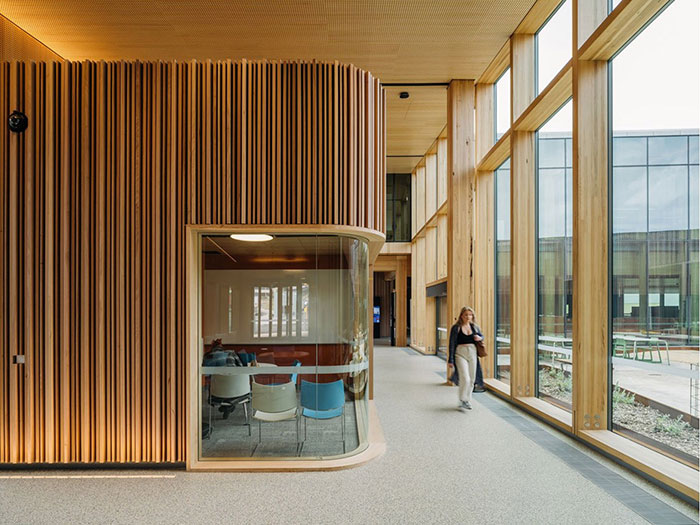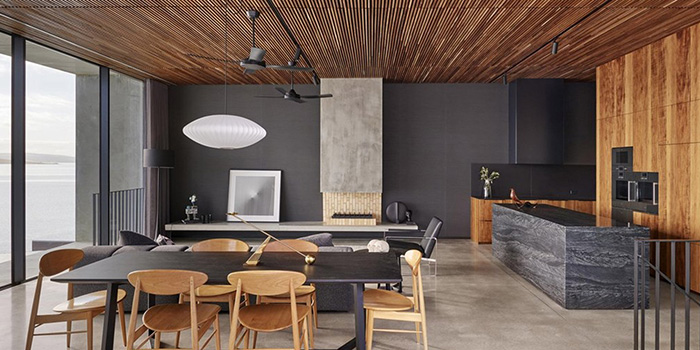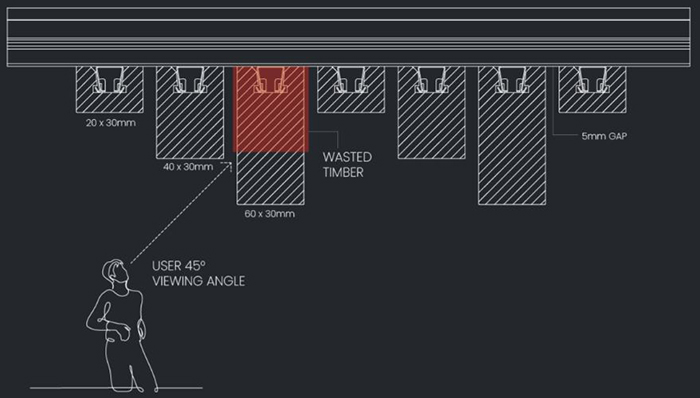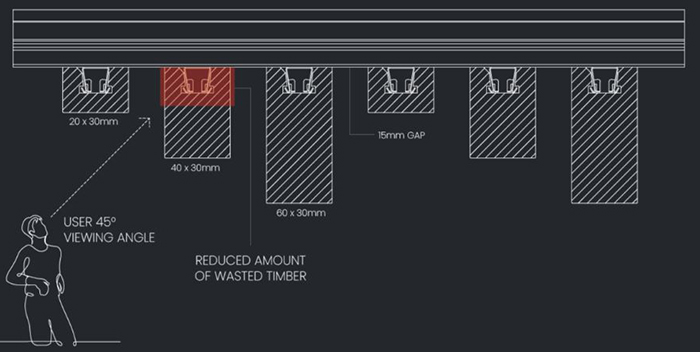In the realm of contemporary design, timber battens stand out as a popular choice, seamlessly aligning with the principles of biophilic design. This design approach, which incorporates natural elements into the built environment, resonates deeply with the aesthetic and psychological needs of today’s society. However, the increasing cost of raw timber presents a significant challenge for architects and designers looking to incorporate this material into their projects.
Timber battens, while highly sought after for their natural appeal and ability to create a connection with nature, now require more thoughtful consideration in terms of cost management.
This blog aims to explore various strategies and design solutions to use timber battens effectively and economically, ensuring their benefits can be enjoyed without an unrealistic financial burden.

Tasmanian Oak battens installed at the University of Tasmania | John Wardle Design | Photo Credit: Britton Timbers
1. Choosing economical species for your timber battens
Selecting the right type of timber is a crucial part of balancing cost and design intent. While American White Oak has been a top choice in interior design for its sophisticated look, its price has seen a significant rise in the last 24 months.
For those seeking a similar aesthetic at a more economical price, Tasmanian Oak emerges as an attractive alternative.

American Oak (Left) Vs Tasmanian Oak (Right)
It not only offers a similar visual appeal but also provides a cost-effective solution, especially when finishing with a tinted coating to mimic the look of a more expensive species.
Furthermore, Blackbutt, another popular choice, has experienced an increase in supply costs, partly due to the impact of the Australian Bushfires in 2018. In this context, Tasmanian Oak stands out as a viable substitute. Its versatility and affordability, combined with the right coating, can closely match the look and feel of Blackbutt, making it an excellent option for budget-conscious projects.
For designs that require timber with rich and natural colour variation, Tasmanian Blackwood offers an economical alternative to Spotted Gum.
Tasmanian Blackwood is renowned for its stunning natural hues and patterns, providing a visually appealing and cost-effective solution for projects where aesthetic diversity is a priority.
This strategic approach to selecting timber species ensures that designers can maintain their creative timber vision while adapting to market changes and client cost considerations.

A beautiful example of Tasmanian Blackwood’s natural colour variation | Photo credit: Britton Timbers
2. Optimising batten spacing
Adjusting the spacing between timber battens is an effective strategy to achieve cost savings while maintaining the design’s aesthetic integrity. By modestly increasing the gap, say by 5-10mm in designs where the spacing of the original is within the range of 10-20mm, you can expect to see a cost reduction ranging from 5-10%. This slight alteration in spacing often goes unnoticed, especially if a black acoustic blanket is installed behind the battens, which can visually mask the increased gap.
When considering where to begin with batten spacing, a useful tip is to look at the depth of the batten profile you’ve selected. A widely accepted design principle suggests using two-thirds of the batten’s depth as a guideline for the spacing. For example, with a batten that has a depth of 60mm, two-thirds would be 40mm, making this a recommended starting point for the spacing.

Why is this approach effective? When viewing the batten feature at a 45-degree angle, this spacing ensures that a significant portion of the batten’s depth is visible, maximising the visual impact of the chosen profile. If the spacing is too narrow, like 15mm for instance, much of the batten’s depth may not be visible, leading to a potential waste of material. In such cases, it might be more practical to opt for a smaller batten profile, such as 20mm depth by 30mm width. This adjustment can yield to a similar larger effect while requiring only a third of the material, further enhancing cost efficiency.
3. Reorienting timber batten profiles
The way timber battens are oriented in a design can have a notable impact on both cost and coverage. By adjusting the orientation of the battens, it’s possible to maximise surface area while minimising material usage. For example, positioning battens with a dimension of 60mm width by 30mm depth, as opposed to a 30mm width by 60mm depth, can significantly extend coverage across a given area. This strategic reorientation means fewer battens are needed to achieve a similar linear effect, drastically reducing your design cost.

In the evolving landscape of architectural design, timber battens continue to be a favoured element, harmonising effortlessly with biophilic design principles. The strategies outlined in this blog – from selecting economical timber species to optimising batten spacing and reorienting batten profiles – are pivotal in managing the cost-effectiveness of timber batten usage.
These approaches allow designers to navigate the challenges of rising raw material costs while retaining the aesthetic and functional integrity of their designs. By implementing these cost-saving measures, architects and interior designers can continue to harness the natural beauty and versatility of timber battens, ensuring their projects are both financially viable and visually stunning.
Ready to elevate your design project with timber battens? Connect with us at MBS Architectural for expert guidance and top-quality materials tailored to your needs. Let’s create sustainable, cost-effective, and aesthetically pleasing spaces together.

